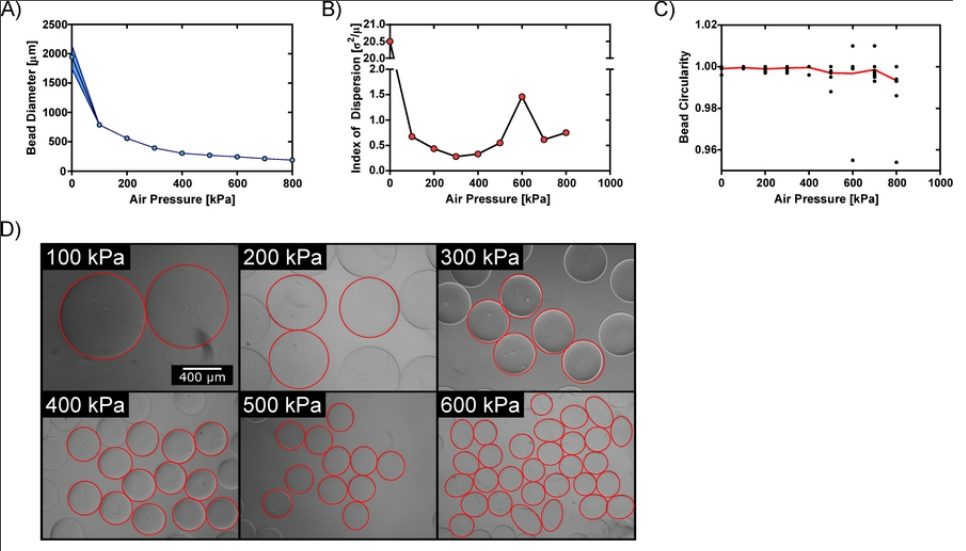In the recently published ‘Open-source 3D printed air-jet for generating monodispersed alginate microhydrogels,’ University of California Davis researchers explore a new design for creating bioprinting materials.
In 3D printing hydrogel microbeads in a ‘controllable size,’ the researchers were able to create a model to work from, studying the potential for alginate microbeads in a variety of other applications. Microbead generators use polymers and crosslinker solutions in producing microscale hydrogel, and are being studied for biomedical applications, to include drug and cell delivery.
“In these biomedical science applications, alginate is a particularly attractive polymer for microbeads, as it is biocompatible, undergoes rapid gelation under gentle conditions, and enables controllable mesh size,” state the researchers. “Alginate, a copolymer comprised of (1,4)-linked β-D-mannuronate (M) and α-L-guluronate (G) residues, crosslinks in the presence of divalent cations, such as Ca2+, resulting in the formation of a 3D polymeric network characteristic of hydrogels.”
Alginate microbeads are commonly generated using:
- Droplet microfluidics
- Coaxial airflow units
- Two-channel air-jackets
- High voltage
Here, the researchers created a new 3D printed air-jet system inspired by air bifurcation and electrostatic bead generators, with both modularity and sterility as goals in design and functionality. The research team used Fusion 360 for design, and Cura software for slicing (splitting the design into the air-jet, air intake, and supports). Parts were printed on an MP Select Mini V2, using PLA filament.
The new design of this system allows for use of a needle and syringe, through attachment to the pump or adjustable stands.
Overall, the design was simple and open source, resulting in microbeads without any requirement for complicated assembly or sophisticated lab equipment. The air-jet offers benefits like reproducibility and reliability, and the researchers state that this is the first fully 3D printable air-jet system that they know of, ‘offering control over microbeads with defined set-up parameters.’ They were also able to harness bacteria and alginate lyase, encapsulating cargo able to break down the hydrogel matrix.
“Here, we load microbeads with bacteria, and their growth over 24 hours results in pockets of bacteria within the hydrogel matrix. The encapsulation of bacteria is promising for numerous biomedical applications, including probiotic delivery, especially for anaerobic bacteria sensitive to atmospheric oxygen concentrations,” concluded the researchers. “By using the air-jet system with nitrogen gas in a nitrogen-enriched chamber, microbeads could be rapidly generated with anaerobic bacteria while displacing oxygen. Furthermore, the use of enzymes to degrade alginate has been previously used to control the delivery of endothelial progenitor cells and adeno-associated vectors.
“The system’s modular design allows easy cleaning, interchangeability to customized set-ups, and rapid replacement. We have demonstrated that alginate microbeads can be generated using this open-source air jet system with reasonable microbead diameters and variance,” stated the researchers. “We anticipate the system will enable other research laboratories, as well as other fields, to easily generate polymeric microbeads.”
Better ways to 3D print and bioprint emerge constantly as researchers innovate out of need for their own projects, and manufacturers are motivated by the need to replace and maintain parts, or many times, create completely new 3D printed components that would not have been possible previously. What do you think of this news? Let us know your thoughts! Join the discussion of this and other 3D printing topics at 3DPrintBoard.com.
[Source / Images: ‘Open-source 3D printed air-jet for generating monodispersed alginate microhydrogels’]
Subscribe to Our Email Newsletter
Stay up-to-date on all the latest news from the 3D printing industry and receive information and offers from third party vendors.
You May Also Like
Immensa and Pelagus 3D Collaborate to Tap “$2 Billion” 3D Printing Opportunity
Dubai’s Immensa, which claims to be the “largest digital manufacturer” in the Middle East/North Africa (MENA) region, has formed a strategic collaboration with Pelagus 3D, a Singapore-based, on-demand digital manufacturing...
US Army Contracts 3YOURMIND & Phillips Corp. for 3D Printed Tank Parts Identification
The US Army Combat Capabilities Development Command (DEVCOM) Ground Vehicle Systems Center (GVSC) has awarded 3YOURMIND and Phillips Corporation Federal Division a contract to develop part identification solutions for tanks....
Manufacturing World Tokyo 2024 Set to Showcase Innovation in AM, 3D Printing and More!
After the success of its Nagoya leg last April, Manufacturing World Tokyo 2024, one of Asia’s premier manufacturing exhibitions, is gearing up for its second leg this year, returning to...
3D Printing Webinar and Event Roundup: May 19, 2024
This week, Stratasys continues its advanced training and starts its Experience Stratasys tour across the United States. ASTM’s AMCOE continues its professional certificate course, and SPE is offering a workshop...




































